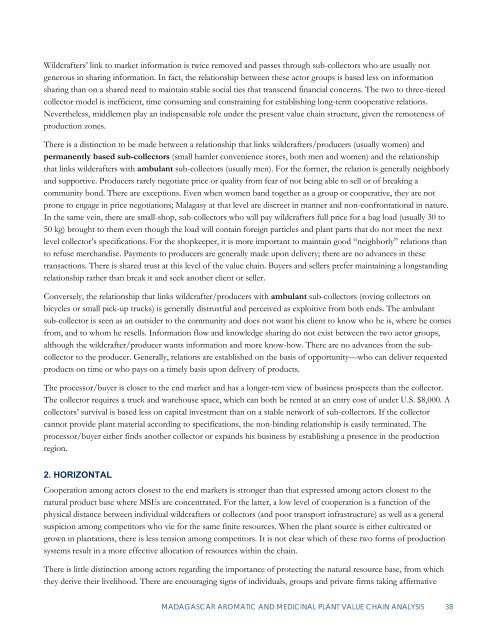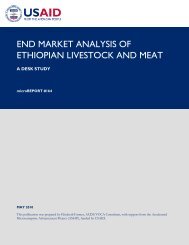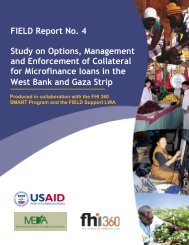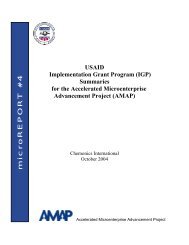Madagascar Aromatic and Medicinal Plants Value - Microlinks
Madagascar Aromatic and Medicinal Plants Value - Microlinks
Madagascar Aromatic and Medicinal Plants Value - Microlinks
You also want an ePaper? Increase the reach of your titles
YUMPU automatically turns print PDFs into web optimized ePapers that Google loves.
Wildcrafters’ link to market information is twice removed <strong>and</strong> passes through sub-collectors who are usually not<br />
generous in sharing information. In fact, the relationship between these actor groups is based less on information<br />
sharing than on a shared need to maintain stable social ties that transcend financial concerns. The two to three-tiered<br />
collector model is inefficient, time consuming <strong>and</strong> constraining for establishing long-term cooperative relations.<br />
Nevertheless, middlemen play an indispensable role under the present value chain structure, given the remoteness of<br />
production zones.<br />
There is a distinction to be made between a relationship that links wildcrafters/producers (usually women) <strong>and</strong><br />
permanently based sub-collectors (small hamlet convenience stores, both men <strong>and</strong> women) <strong>and</strong> the relationship<br />
that links wildcrafters with ambulant sub-collectors (usually men). For the former, the relation is generally neighborly<br />
<strong>and</strong> supportive. Producers rarely negotiate price or quality from fear of not being able to sell or of breaking a<br />
community bond. There are exceptions. Even when women b<strong>and</strong> together as a group or cooperative, they are not<br />
prone to engage in price negotiations; Malagasy at that level are discreet in manner <strong>and</strong> non-confrontational in nature.<br />
In the same vein, there are small-shop, sub-collectors who will pay wildcrafters full price for a bag load (usually 30 to<br />
50 kg) brought to them even though the load will contain foreign particles <strong>and</strong> plant parts that do not meet the next<br />
level collector’s specifications. For the shopkeeper, it is more important to maintain good “neighborly” relations than<br />
to refuse merch<strong>and</strong>ise. Payments to producers are generally made upon delivery; there are no advances in these<br />
transactions. There is shared trust at this level of the value chain. Buyers <strong>and</strong> sellers prefer maintaining a longst<strong>and</strong>ing<br />
relationship rather than break it <strong>and</strong> seek another client or seller.<br />
Conversely, the relationship that links wildcrafter/producers with ambulant sub-collectors (roving collectors on<br />
bicycles or small pick-up trucks) is generally distrustful <strong>and</strong> perceived as exploitive from both ends. The ambulant<br />
sub-collector is seen as an outsider to the community <strong>and</strong> does not want his client to know who he is, where he comes<br />
from, <strong>and</strong> to whom he resells. Information flow <strong>and</strong> knowledge sharing do not exist between the two actor groups,<br />
although the wildcrafter/producer wants information <strong>and</strong> more know-how. There are no advances from the subcollector<br />
to the producer. Generally, relations are established on the basis of opportunity—who can deliver requested<br />
products on time or who pays on a timely basis upon delivery of products.<br />
The processor/buyer is closer to the end market <strong>and</strong> has a longer-tem view of business prospects than the collector.<br />
The collector requires a truck <strong>and</strong> warehouse space, which can both be rented at an entry cost of under U.S. $8,000. A<br />
collectors’ survival is based less on capital investment than on a stable network of sub-collectors. If the collector<br />
cannot provide plant material according to specifications, the non-binding relationship is easily terminated. The<br />
processor/buyer either finds another collector or exp<strong>and</strong>s his business by establishing a presence in the production<br />
region.<br />
2. HORIZONTAL<br />
Cooperation among actors closest to the end markets is stronger than that expressed among actors closest to the<br />
natural product base where MSEs are concentrated. For the latter, a low level of cooperation is a function of the<br />
physical distance between individual wildcrafters or collectors (<strong>and</strong> poor transport infrastructure) as well as a general<br />
suspicion among competitors who vie for the same finite resources. When the plant source is either cultivated or<br />
grown in plantations, there is less tension among competitors. It is not clear which of these two forms of production<br />
systems result in a more effective allocation of resources within the chain.<br />
There is little distinction among actors regarding the importance of protecting the natural resource base, from which<br />
they derive their livelihood. There are encouraging signs of individuals, groups <strong>and</strong> private firms taking affirmative<br />
MADAGASCAR AROMATIC AND MEDICINAL PLANT VALUE CHAIN ANALYSIS 38





